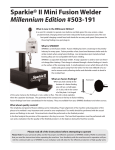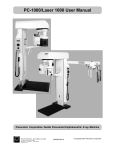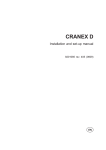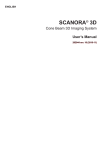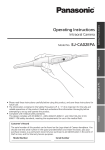Download Cranex Users Manual
Transcript
Cranex Panoramic X-ray Series Contents User’s Manual for the Cranex Excel Cranex Excel Ceph and Cranex BaseX Cassette version (for film and imaging plates) Medical Device Directive 93/42/EEC July 2002 User’s Manual for the Cranex Excel, Cranex Excel Ceph and Cranex BaseX Document number 8200900 ver 0702 Original approved English language version Manufactured by SOREDEX P.O. BOX 250 FIN-00031 SOREDEX, FINLAND Tel. +358 10 394 8412 Fax. + 358 9 701 5261 User’s Manual 8200900 i Cranex Panoramic X-ray Series Contents Soredex endeavours to produce product documentation that is accurate and up to date. However, our policy of continual product development may result in changes to products that are not reflected in the product documentation. Therefore, this document should not be regarded as an infallible guide to current product specifications. Soredex maintains the right to make changes and alterations without prior notice. ii 8200900 User’s Manual Cranex Panoramic X-ray Series Contents Contents 1. The Excel, Excel CEPH and BaseX x-ray units ............................. 1 Introduction ...................................................................................................... Using this manual ............................................................................................. Warnings and precautions............................................................................... Check list before using the unit ...................................................................... General .......................................................................................................... If you are using film ........................................................................................ If you are using imaging plates ....................................................................... Symbols that appear on the units ................................................................... 1 2 3 5 5 5 6 7 2. Unit description .............................................................................. 9 The Excel .......................................................................................................... 9 The Excel CEPH .............................................................................................. 10 The BaseX ........................................................................................................ 11 The Control panel - Excel and Excel CEPH .................................................. 12 The Control panel - BaseX ............................................................................. 13 Chin Supports ................................................................................................. 14 3. Using the Unit ............................................................................... 15 Switching the unit on and off ........................................................................ Switching the unit on ..................................................................................... Switching the unit off .................................................................................... Exposure switch lock ..................................................................................... Unlocking the exposure switch ...................................................................... Locking the exposure switch ........................................................................ Operating the unit without x-rays ................................................................. Taking Panoramic exposures ........................................................................ Panoramic exposure programs ..................................................................... Preparing the unit ......................................................................................... Positioning the patient for a panoramic exposure ......................................... Positioning the patient for a Sinus exposure ................................................. Positioning the patient for a TMJ exposure (Excel and Excel CEPH only) ................................................................... Taking an exposure ...................................................................................... After exposure .............................................................................................. Taking Cephalometric exposures (Excel CEPH only) .................................. Cephalometric exposure programs ............................................................... Taking a cephalometric exposure ................................................................. User’s Manual 8200900 15 15 15 16 16 16 17 18 18 19 24 31 32 33 36 37 37 38 iii Cranex Panoramic X-ray Series Contents 4. Care and Maintenance ................................................................. 44 Cleaning the unit ............................................................................................ Painted surfaces ........................................................................................... Positioning mirror and light lenses ................................................................ Surfaces that the patient comes into contact with .......................................... Monitoring the operation of the unit ............................................................. Maintenance ................................................................................................... Yearly ............................................................................................................ Troubleshooting ............................................................................................. 44 44 44 44 45 45 45 46 5. Technical specifications ............................................................ 47 Unit dimensions ............................................................................................ 52 iv 8200900 User’s Manual Cranex Panoramic X-ray Series 1. Introduction 1. The Excel, Excel CEPH and BaseX x-ray units Introduction This manual describes how operate the Cranex Excel, Cranex Excel CEPH and Cranex BaseX dental x-ray units. The Excel is a panoramic dental unit that can take full and reduced width panoramic exposures, sinus exposures, partial panoramic exposures and TMJ exposures. The Excel CEPH can take the same range of panoramic programs as the Excel, but includes a cephalometric unit. The BaseX is a simplified version of the Excel. It can take full and reduced width exposures and sinus exposures. In addition, height adjustment is manual and not motor driven as it is with the Excel. All versions use conventional film or imaging plates as the image receptor. Please read these instructions carefully before using the x-ray unit. User’s Manual 8200900 5 1. Introduction Cranex Panoramic X-ray Series Using this manual All key illustrations indicate that the key must be pressed. A white circle indicates that the indicator light is on. When the light is on it indicates that the value or setting is on or has been selected A black circle indicates that the light is off and the value or setting is off or has not been selected. 6 8200900 User’s Manual Cranex Panoramic X-ray Series 1. Introduction Warnings and precautions User’s Manual 8200900 • These dental x-ray units must only be used to take dental and, where appropriate, cephalometric x-ray exposures. These dental x-ray units must not be used to take any other x-ray exposures. • The x-ray unit or its accessories must not be modified, altered or remanufactured in any way. • The x-ray unit may be dangerous to both patient and operator unless safe exposure values are used and correct operating procedures are observed. • As radiation safety and protection requirements vary from country to country and state to state it is the responsibility of the operator to ensure that all local and national radiation safety and protection requirements are met. • When taking exposures operators must protect themselves from radiation. • When taking exposures operators must stand at least two metres (six feet) from the patient. • Operators must be able to see and hear the patient during an exposure. • Operators must be able to see the exposure warning lights and hear the exposure warning signal during exposures. If the x-ray unit is located in such a position that the operator cannot see the exposure warning lights, an external exposure warning light must be used. Contact your dealer for help. • Avoid taking exposures of pregnant women. 7 1. Introduction 8 Cranex Panoramic X-ray Series • If you are using film as the image receptor, never leave the film cassettes open in daylight. • If you are using imaging plates as the image receptor make sure that the imaging plates, imaging plate cassettes and imaging scanning device are compatible with each other. 8200900 User’s Manual Cranex Panoramic X-ray Series 1. Introduction Check list before using the unit General • Read and familiarize yourself with the Warnings and Precautions in the introduction. • Make sure that you are fully acquainted with the relevant radiation protection measures. • Make sure that all the required radiation protection equipment, such as radiation screens, are of the approved type and, where necessary, correctly installed. If you are using film User’s Manual 8200900 • Make sure that the film processor you plan to use is in working order and ready to use. • Make sure that the processing chemicals in the film processor are fresh and are at the correct processing temperatures and concentrations. • Make sure that the safelight in the darkroom is the correct one for the film you are using. • Make sure that the film you are using is fresh. Do not use old film. • Make sure that the film and cassettes/intensifying screens you are using are compatible. Do not mix films and screens of different colour sensitivity. • Make sure that the intensifying screens are clean and not scratched. If they are scratched do not use the cassette. 9 1. Introduction Cranex Panoramic X-ray Series If you are using imaging plates 10 • Make sure that the imaging plates that you are using are compatible with the imaging plate cassettes. • Make sure that the imaging plate scanning device you are using is designed to scan the imaging plates you are using. • Make sure that the imaging plates are clean and not scratched or damaged. If they are, do not use them. 8200900 User’s Manual Cranex Panoramic X-ray Series 1. Introduction Symbols that appear on the units User’s Manual 8200900 11 1. Introduction 12 Cranex Panoramic X-ray Series 8200900 User’s Manual Cranex Panoramic X-ray Series 2. Unit description 2. Unit description The Excel User’s Manual 8200900 13 2. Unit description Cranex Panoramic X-ray Series The Excel CEPH The Excel CEPH is the same as the Excel but includes a cephalometric unit 14 User’s Manual 8200900 Cranex Panoramic X-ray Series 2. Unit description The BaseX User’s Manual 8200900 15 2. Unit description Cranex Panoramic X-ray Series The Control panel - Excel and Excel CEPH 16 User’s Manual 8200900 Cranex Panoramic X-ray Series 2. Unit description The Control panel - BaseX User’s Manual 8200900 17 2. Unit description Cranex Panoramic X-ray Series Chin Supports 18 User’s Manual 8200900 Cranex Panoramic X-ray Series 3. Using the Units 3. Using the Units Switching the unit on and off The on/off switch is located on the side of the unit. Switching the unit on Press the on/off switch to the on position (I) to switch the unit on. The on/off switch light and display lights for the preselected spinal compensation, mA and kV values will come on. Switching the unit off Press the on/off switch the off (0) position. All the lights will go out. Switch the unit off at the end of every day or when it is not being used It is also recommended that the exposure switch (see next page) is locked when the unit is not being used. User’s Manual 8200900 19 3. Using the Units Cranex Panoramic X-ray Series Exposure switch lock The exposure switch lock allows the exposure switch to be locked. This prevents unauthorized people from taking exposures even if the unit is switched on. The exposure switch lock is located on the side of the unit below the on/off switch. Unlocking the exposure switch Insert the key into the exposure switch lock and turn the key clockwise to the horizontal unlocked position. Locking the exposure switch Turn the key anticlockwise to the vertical locked position and then remove the key. 20 User’s Manual 8200900 Cranex Panoramic X-ray Series 3. Using the Units Operating the unit without x-rays In some situations you may have to operate the unit without x-rays being generated. To do this, press the test (T) key, the indicator light will come on. The exposure switch can now be pressed to demonstrate how the unit operates without x-rays being generated. User’s Manual 8200900 21 3. Using the Units Cranex Panoramic X-ray Series Taking Panoramic exposures Panoramic exposure programs The following images can be taken with the Excel, Excel CEPH and BaseX. Full-width panorama Magnification 1.3 Reduced width panorama (-20%) pedo and sinus Magnification 1.3 The following images can only be taken with the Excel and Excel Ceph. Frontal area of the mandible and maxilla Excel and Excel Ceph only Magnification 1.3 Right-hand side of the mandible and maxilla Excel and Excel Ceph only Magnification 1.3 Left-hand side of the mandible and maxilla Excel and Excel Ceph only Magnification 1.3 TMJ, two or four images on the film Excel and Excel Ceph only Magnification 1.3 22 User’s Manual 8200900 Cranex Panoramic X-ray Series 3. Using the Units Preparing the unit 1. Switch the unit on. 2. Press the Return key to drive the rotating unit to the ready position if it is not already in that position. 3. Push the cassette carriage to the right and then slide a cassette with film or a cassette with imaging plate into the cassette carriage. Slide the cassette in until the right-hand end of the cassette lines up with the two slots. Arrows indicate the position of the slots. Note that film cassettes and imaging plate cassettes are not the same and are NOT interchangeable. User’s Manual 8200900 23 3. Using the Units Cranex Panoramic X-ray Series 4. Select the exposure program you require. Excel and Excel CEPH units only Press the appropriate program key. The program light will come on. The programs are as follows: Normal panoramic or sinus exposure Reduced width panorama (-20%) pedo or sinus exposure Temporomandibular joint (TMJ) exposures, images on film sides Temporomandibular joint (TMJ) exposures, images in film centre When taking TMJ exposures two pairs of exposures can be taken, mouth open and mouth closed, on one film. Press one of the TMJ keys for the first pair of exposures and then press the other TMJ key and reposition the patient for the second pair of exposures. Frontal (anterior) exposure Partial exposure, right-hand side of patient Partial exposure, left-hand side of patient 24 User’s Manual 8200900 Cranex Panoramic X-ray Series 3. Using the Units BaseX only Turn the program selection knob on the side of the cassette carriage to select the required exposure program. The programs are as follows: Adult for normal panoramic or sinus exposure Child for Reduced width panorama (-20%) pedo or sinus exposure 5. Press the mA key to select the correct mA for the image receptor you are using. Select 10 mA for normal-speed film/screen combinations. Note that 10mA can be used with high-speed film/screen combinations, but the kV value will have to be decreased accordingly. Select 6 mA for high-speed film/screen combinations. For imaging plates select an mA value for the required image quality and dose level. User’s Manual 8200900 25 3. Using the Units Cranex Panoramic X-ray Series 6. If you are taking a panoramic exposure of an adult, press the spinal compensation button to activate spinal compensation. The “I” light will come on. With spinal compensation the mA is decreased in the lateral areas of the exposure. If you are taking a panoramic exposure of a child, a sinus exposure or TMJ exposures, DO NOT activate spinal compensation. The “O” light must be on 7. Select the chin support for the exposure you wish to take. For panoramic exposures, use the chin support and bite block or if the patient is edentulous, the chin cup or the chin rest if you cannot use either of the above with the patient. For sinus and TMJ exposures, use the chin rest. CAUTION: Always use the disposable covers with the chin supports. 26 User’s Manual 8200900 Cranex Panoramic X-ray Series 3. Using the Units 8. Ask the patient to remove any dentures, jewellery or spectacles and then place a lead apron over the patient’s back. 9. Adjust the height of the chin rest so that it is level with the patient’s chin. Excel and Excel CEPH With the Excel and Excel CEPH, press the height adjusting key to position the chin rest. BaseX With the BaseX, turn the locking lever downwards to unlock the chin rest. Adjust the position of the chin rest and then relock it by turning the locking lever back to the locked position. User’s Manual 8200900 27 3. Using the Units Cranex Panoramic X-ray Series Positioning the patient for a panoramic exposure 1. Ask the patient to step into the unit and grasp the patient handles. Slide the cassette carriage to the right as far as it will go so that you can see the patient. 2. If you are using the chin rest and bite block ask the patient to place his chin on the chin support and bite the bite block. Make sure that the patient’s upper and lower teeth are positioned in the respective notches on the top and bottom of the bite block. If you are using the chin cup ask the patient to position the upper and lower central incisors so that the biting edges are together. If you are using the chin rest ask the patient to position the upper and lower central incisors so that the biting edges are together and then press his lower lip against the chin rest. 28 User’s Manual 8200900 Cranex Panoramic X-ray Series 3. Using the Units 3. While the patient is holding the patient handles ask the patient to step forward a few centimetres so that patient is slightly off balance. This movement will encourage the patient to push their head forward in order to maintain balance. In this position the patient's cervical vertebrae will be stretched and straight and the patient will be in the best position for taking a panoramic exposure. If necessary adjust the height of the chin rest to “stretch” the patient. 4. Open the mirror so that you can see a reflection of the patient in the mirror. User’s Manual 8200900 29 3. Using the Units Cranex Panoramic X-ray Series 5. Press the positioning light button to switch the patient positioning lights on. The lights will remain on for 30 seconds. If you need more time, press the button again. 6. Look at the reflection of the patient in the mirror and position the midsagittal plane of the patient so that it is vertical. The patient’s head must be positioned symmetrically and the patient must be looking straight ahead. The patient’s head is not tilted or turned to one side. If the unit has a midsagittal light, the plane must coincide with the light beam. 30 User’s Manual 8200900 Cranex Panoramic X-ray Series 3. Using the Units 7. Close the temple supports by pushing the temple support lever to the right. NOTE When the temple supports are closed the patient’s head is automatically “measured”. This “measurement” will be used to determine a kV value when the unit is readied for an exposure. 8. Ask the patient to open his lips so that you can see his teeth. Estimate the positions of the root apices of the central upper and lower front incisors. Adjust the tilt of the patient’s head, by raising or lowering the chin support, so that both root apices are on the same vertical axis. User’s Manual 8200900 31 3. Using the Units Cranex Panoramic X-ray Series 9. The focal trough light beam indicates the center of the focal trough, which is 10 mm wide at the front. The root apices of the central upper and lower front incisors must now be positioned so that they are within the focal trough. To do this, rotate the focal trough positioning knob backwards or forwards until the root apices of the central upper and lower front incisors are within the focal trough. For patients with NORMAL occlusion the focal trough light beam will be positioned between the second and third teeth. 32 User’s Manual 8200900 Cranex Panoramic X-ray Series 3. Using the Units 10. For the dental arch to appear correctly on the image the Frankfort plane of the patient should be positioned so that it coincides with or is parallel to the Frankfort plane light. Note however, that this is only for patients with NORMAL occlusion and is only a very rough guide. IMPORTANT NOTE The most important factor in patient positioning is the position of the upper and lower apices of the central incisors. They MUST be positioned within the focal trough even if it means ignoring the position of the Frankfort plane. User’s Manual 8200900 33 3. Using the Units Cranex Panoramic X-ray Series 11. Slide the forehead support towards the patient until it touches the patent's forehead. 34 User’s Manual 8200900 Cranex Panoramic X-ray Series 3. Using the Units Positioning the patient for a Sinus exposure 1. For sinus exposures use the chin rest. Ask the patient to press his upper lip against the chin rest. 2. The midsagittal plane is positioned the same as for a panoramic exposure. 3. Position the focal trough light as far backwards as possible. 4. The Frankfort plane must be horizontal. User’s Manual 8200900 35 3. Using the Units Cranex Panoramic X-ray Series Positioning the patient for TMJ exposures (Excel and Excel CEPH only) 1. For TMJ exposures use the chin rest. Ask the patient to press his upper lip against the chin rest with his mouth closed. 2. The midsagittal plane is positioned the same as for a panoramic exposure. 3. The focal trough is positioned the same as for a panoramic exposure. 4. The Frankfort plane must be horizontal. 5. After taking the first pair of TMJ exposures ask the patient to open his mouth for the second pair of exposures. 36 User’s Manual 8200900 Cranex Panoramic X-ray Series 3. Using the Units Taking an exposure 1. Make sure that the temple supports are closed so that they are holding the patient’s head. Press the RETURN key to drive the rotating unit to the start position. 2. Manually slide the cassette carriage to the left as far as it will go. The READY light will come on and a kV value based on the patient’s head size will be automatically selected. This kV value is for a normal panoramic exposure with spinal compensation ON, using 10mA and a normal-speed film/screen combination. IMPORTANT NOTE The Autoset kV value selected is only a SUGGESTED value based upon the size of the patient’s head. You should always use your own experience and knowledge when deciding what kV value to use. If a high-speed film/screen combination is being used, decrease the kV value by 6 - 8 kV or use 6 mA instead of 10 mA. User’s Manual 8200900 37 3. Using the Units Cranex Panoramic X-ray Series For different exposure programs and patients adjust the suggested kV value as follows: - sinus exposure (spinal compensation OFF), increase the kV value by 4 - 6 kV. -TMJ exposure (spinal compensation OFF), increase the kV value by 2 - 4 kV. - panoramic exposure heavy boned patient, increase the suggested value by 2 - 4 kV - panoramic exposure of an edentulous patient, decrease the suggested value by 2 - 4 kV. - panoramic exposure WITHOUT spinal compensation, decrease the suggested value by 2 4 kV. If you cannot increase or decrease the kV value by the number of kV required, just select the highest or lowest kV value possible. Note that when using film, the age of the processing chemicals and the film/screen combination being used may also require the kV value to be adjusted. 3. Ask the patient to press his tongue against his palate, breathe normally and not move until the exposure has been completed. Exposures last approximately 20 seconds. 4. Move at least two metres away from the x-ray unit and protect yourself from radiation. Make sure that you are able to see and hear the patient during the exposure. 38 User’s Manual 8200900 Cranex Panoramic X-ray Series 3. Using the Units 5. Press and hold down the exposure switch on the remote control for the duration of the exposure. During the exposure cycle you will hear an audible signal and the radiation warning lights will come on when radiation is generated. 6 When the rotating arm stops moving and the exposure warning lights go out, remove your finger from the exposure switch. NOTE TMJ Exposures (Excel and Excel CEPH only) If you are taking TMJ exposures: Press the RETURN key after you have taken the first pair of exposures to drive the rotating unit back to the ready position. Press the second TMJ exposure key. Reposition the patient for the second pair of TMJ exposures (Refer to the section “Positioning the patient for a TMJ exposure”) and then take these exposures as described above. NOTE When taking TMJ exposures, the audible signal and the radiation warning lights will ONLY come on when radiation is generated. User’s Manual 8200900 39 3. Using the Units Cranex Panoramic X-ray Series After exposure 1. Slide the forehead support away from the patient. 2. Open the temple supports. 3. Guide the patient out of the x-ray unit. 4. Remove the cassette from the cassette carriage. Process the film or if you used an imaging plate, scan the imaging plate. 40 User’s Manual 8200900 Cranex Panoramic X-ray Series 3. Using the Units Taking Cephalometric exposures (Excel CEPH only) Cephalometric exposure programs Only the Excel CEPH can also be used to take the following cephalometric images. Lateral asymmetric vertical 18 x 24 cm / 8” x 10” or optionally 24 x 30 cm Anterior-posterior or posterior anterior symmetric vertical 18 x 24 cm / 8” x 10” or optionally 24 x 30 cm Lateral horizontal 18 x 24 cm / 8” x 10” or optionally 24 x 30 cm The magnification of all these images is 1.13. (NOTE: For non US units the magnification can be set between 1.09 and 1.13 during installation. ) User’s Manual 8200900 41 3. Using the Units Cranex Panoramic X-ray Series Taking a cephalometric exposure 1. Select and press the ceph exposure time button for patient you are taking an exposure of: - For adults 1.0 - 2.0 seconds - For children 0.4 - 1.0 seconds Note The exposure time will depend on the film/screen combination being used. The exposure time indicator light will come on and the rotating unit and cassette carriage will move automatically to the ceph position. CAUTION DO NOT pull the cassette carriage out past its stop position. If pulled out too far the unit will NOT take a ceph exposure. If accidentally pulled out, push the cassette carriage in as far as it will go and it will then return automatically to the correct position. DO NOT push the rotating arm to the left. If pushed, it will start rotating. If the rotating arm is accidentally pushed and it starts to move, pull it to the right passed the ceph position and it will move automatically back to the ceph position. 42 User’s Manual 8200900 Cranex Panoramic X-ray Series 3. Using the Units 2. Select 10 mA, a kV value of at least 71 kV and switch spinal compensation OFF (0). 3. Slide the aperture plate to the aperture you require for the cephalometric exposure you wish to take. User’s Manual 8200900 43 3. Using the Units Cranex Panoramic X-ray Series For a lateral exposure using the cassette in the asymmetrical vertical position slide the aperture plate to the DOWN position. For a PA or AP exposure using the cassette in symmetrical vertical position slide the aperture plate to the MIDDLE position. For a lateral exposure using the cassette in the horizontal position slide the aperture plate to the UP position. 4. Pull the locking catch down and then rotate the headrest until it is in the correct position for the cephalometric exposure you plan to take. Also place disposable covers over the ear posts. 44 User’s Manual 8200900 Cranex Panoramic X-ray Series 3. Using the Units 5. Ask the patient to stand between the open ear posts. Adjust the height of the head support until the earposts can be inserted into the patients ears. Close the ear supports. WARNING NEVER drive the ceph head support up or down when the earposts are in the patient’s ears. 6. If you are taking a lateral exposure and require soft tissue filtering, determine which of the soft tissue indicator lines on the cephalometric cassette holder is nearest to the patients nasion. Rotate the soft tissue filter adjusting screw until the position line on the screw is the same as the line chosen on the ceph cassette holder. User’s Manual 8200900 45 3. Using the Units Cranex Panoramic X-ray Series 7. Slide the cephalometric cassette into the cassette holder until it lines up with the cassette positioning mark for the exposure you wish to take. 8. If you are taking an AP exposure, ask the patient to close his eyes. Protect yourself from radiation and take the exposure. 9. Guide the patient out of the unit. 10. Remove the cassette and process the film or scan the imaging plate. 46 User’s Manual 8200900 Cranex Panoramic X-ray Series 3. Using the Units 11. To drive the rotating arm back to the panoramic position press the P key and then the RETURN key. User’s Manual 8200900 47 4. Care and Maintenance Cranex Panoramic X-ray Series 4. Care and Maintenance Cleaning the unit WARNING Switch the unit off before cleaning it. Painted surfaces All painted surfaces can be wiped clean with a soft cloth dampened with a mild detergent. NEVER use abrasive cleaning agents or polishes on this equipment. Positioning mirror and light lenses The positioning mirror and positioning light lenses are made of glass. Use a soft cloth dampened with a mild detergent. NEVER use abrasive cleaning agents or polishes. Surfaces that the patient comes into contact with All surfaces and parts that the patient touches or comes into contact with must be disinfected after each patient. If you need to clean the intensifying screens, only use cleaners recommended by the screen manufacturer. If you need to clean the imaging plates, only use cleaners recommended by the imaging plate manufacturer. 48 User’s Manual 8200900 Cranex Panoramic X-ray Series 4. Care and Maintenance Monitoring the operation of the unit If any of the unit’s controls or functions fail to operate or do not operate in the way described in this manual, switch the unit off, wait 30 seconds and then switch the unit on again. If the unit still does not operate correctly contact your service technician for help. If you hear the exposure warning tone but the exposure warning light does not come on when an exposure is taken, stop using the unit and contact your service technician for help. If you do not hear the exposure warning tone when an exposure is taken, stop using the unit and contact your service technician for help. Maintenance Yearly Once a year an authorized service technician must carry out a full inspection of the unit. During the inspection the following will be carried out: – a kV/mA test – a ceph exposure time test (where applicable) – a beam alignment test – a ball/pin test – a check to see that the safety ground is connected – a check to see that the positioning lights operate – a check to see that the tube head is not leaking – a check to see that all covers and mechanical parts are correctly secured and have not come loose. A full description of all the tests and checks is described in the Service Manual. User’s Manual 8200900 49 4. Care and Maintenance Cranex Panoramic X-ray Series Troubleshooting Problem The protection light comes on and you are unable to take an exposure. Cause There is a problem with the generator. Solution Switch the unit off. After a few seconds switch it on again. If the light comes on again, contact your dealer for assistance. 50 User’s Manual 8200900 Cranex Panoramic X-ray Series 5. Technical Specifications 5. Technical specifications Classification Complies with IEC class I type B, IPX0 Complies with IEC 601-1, IEC 601-2-7 and EN 55011 standards Group 1, class B Complies with DHHS Radiation Performance Standard, 21CFR Subchapter J. The unit must be installed in a protected clinical environment. Description Dental panoramic and panoramic/cephalometric x-ray units with a high frequency switching mode x-ray generators. The panoramic version takes panoramic exposures. The panoramic/cephalometric version takes panoramic and cephalometric exposures and uses a dedicated x-ray source to take cephalometric exposures. Generator TUBE - OPX/105, DE 100/15 or equivalent FOCAL SPOT - 0.5 mm IEC 336 TARGET ANGLE - 5º TARGET MATERIAL - Tungsten OPERATING TUBE POTENTIAL - Panoramic 63 - 81 kV (±5 kV) at preselected settings OPERATING TUBE CURRENT - 6 mA and 10 mA (±1 mA) at preselector, 4.5 mA and 6 mA or 7.5 mA and 10 mA in compensation mode MAXIMUM TUBE CURRENT - 11 mA MAXIMUM OUTPUT POWER - 945 W nominal FILTRATION - minimum filtration 2.5 mm Al BEAM QUALITY - HVL over 2.5 mm Al at 81 kV OUTER SHELL TEMPERATURE - +50ºC (122ºF) maximum DUTY CYCLE - Panoramic: 1:15, 81 kV/10mA - Cephalometric: 1:20, 81 kV/10mA User’s Manual 8200900 51 5. Technical Specifications Cranex Panoramic X-ray Series Power requirements INPUT VOLTAGE - 175-250 VAC (±10%), 50/60 Hz, adjustable, single phase, grounded socket MAXIMUM LINE CURRENT - 7 A at 81 kV/10mA MAXIMUM LINE RESISTANCE - 1 ohm MAXIMUM LINE FUSING - 10 A slow (main fuse 8A slow in device) LINE SAFETY SWITCH (when required) - Approved type, min. 10 A 250 VAC EARTH LEAKAGE CIRCUIT BREAKER (when required) - Approved type, min. 16 A 250 VAC, breaker activation leakage current in accordance with local regulations. Mechanical parameters PANORAMIC - SID 520 mm (±10 mm) - Magnification factor 1.3 CEPHALOMETRIC - SID 1635 - 1700 mm ±20 mm - SID, USA only, fixed 1700 mm ±20 mm - SOD (Source object distance) 1500 - Magnification factor 1.09 - 1.13 (Non US unit, set during installation) - Magnification factor, USA only, fixed 1.13 WEIGHT - Panoramic unit 150 kg (330 lb.) - Pan Ceph unit 195 kg (430 lb.) DIMENSIONS - Panoramic unit (HxWxD) 2240 x 1200 x 970 mm (88" x 47" x 38") - Pan Ceph unit (HxWxD) 2240 x 1200 x 1850 mm (88" x 47" x 74") VERTICAL HEIGHT OF CHIN REST - 850-1700 mm (33"-67") Cassettes PANORAMIC - 15 x 30 cm (6" x 12") Optional 24 x 30 cm (10” x 12”) available CEPHALOMETRIC - 18 x 24 cm (8" x 10") - optionally 24 x 30 cm 52 User’s Manual 8200900 Cranex Panoramic X-ray Series 5. Technical Specifications Recommended image receptors FILM/SCREEN COMBINATIONS Kodak T-MAT G (green sensitive) - Kodak Lanex Regular and Medium IMAGE PLATES All types of imaging plates intended for extraoral imaging. Timer PANORAMIC EXPOSURE TIMES: 50 Hz Normal 19 s (±15%) Child 17 s (±15%) Sides 11 s (±15%) Middle 10 s (±15%) TMJ 3.3 + 3.3 s (±15%) Max 240 mAs 60 Hz 16 s (±15%) 14 s (±15%) 9 s (±15%) 8 s (±15%) 2.8 + 2.8 s (±15%) Max 202 mAs CEPHALOMETRIC EXPOSURE TIMES: - 0.4 - 3.2 s (±15%), ten steps in accordance with R’ 10, series (ISO) - 4 mAs - 32 mAs nominal, maximum 40.4 mAs BACK-UP TIME - 23.5 s (±1.5s) Leakage technique factors PANORAMIC - 81 kV, 2400 mAs/h (81 kV, 10 mA, duty cycle 1:15) (One normal exposure per 4 minutes cool-down period) CEPHALOMETRIC - 81 kV, 1800 mAs/h (81 kV, 10 mA, duty cycle 1:20) (One 3.2 s exposure per 1 minute cool-down period) User’s Manual 8200900 53 5. Technical Specifications Cranex Panoramic X-ray Series Measurement bases - The kV is measured by monitoring the current flowing through a 450 Mohm, 1% feedback resistor connected between the tube anode and ground. - The mA is measured by monitoring current in the HT return line, which equals the tube current. - Both parameters are measured using a Soredex kV/mA meter (pt. no. 4800177) or with a digital multimeter (DMM) according to a specified procedure. The exposure time is measured using a radiation probe positioned in the primary beam. Cephalometric collimator 18 x 24 A or 24 x 18 A for lateral projection, 18 x 24 S for P.A. and A.P. projections 24 x 30 aperture optional 8" x 10" A or 10" x 8" A for lateral projections 8" x 10" S for A.P. and P.A. projections Adjustable soft tissue filter for lateral projection Operating Room Temperature - 15ºC (59ºF) to 32ºC (90ºF) Operating Relative Humidity Maximum - 95% Tube housing assembly cooling characteristics 54 User’s Manual 8200900 Cranex Panoramic X-ray Series Tube rating chart 5. Technical Specifications Anode thermal characteristics OPX/105 Tube rating chart Anode thermal characteristics DE 100/15 ö User’s Manual 8200900 55 5. Technical Specifications Cranex Panoramic X-ray Series Unit dimensions 56 User’s Manual 8200900






























































